As I ran my fingers across the fretboard of a vintage Martin, I was struck by the shimmering abalone inlays that caught the light. In that moment, I realized that guitar inlay materials are more than mere decoration—they’re the soul of an instrument’s visual appeal. With nearly three decades as a luthier and an engineering background, I’ve witnessed firsthand how these intricate details can elevate a guitar from functional to breathtaking. But here’s a bold claim: the right inlay can actually improve your playing. Intrigued? You should be. In this comprehensive guide, we’ll explore the vast world of inlay materials, from classic mother of pearl to cutting-edge synthetics. Whether you’re a seasoned player or a curious beginner, prepare to discover how these tiny embellishments can make a big impact on your guitar’s aesthetics and your connection to the instrument.
Common Guitar Inlay Materials
Mother of Pearl and Abalone
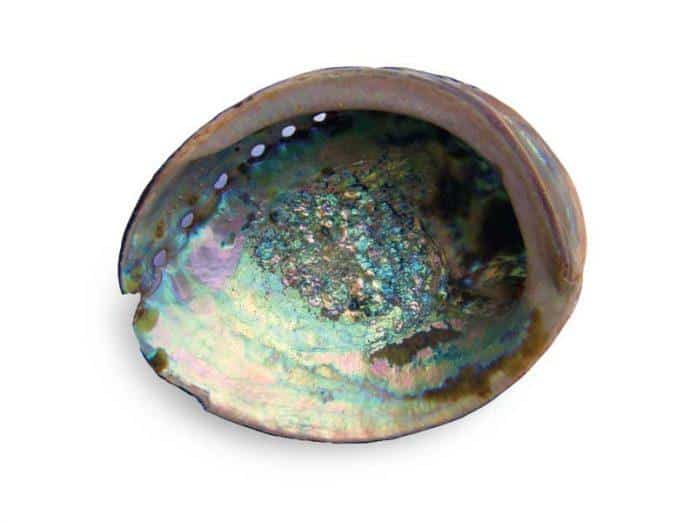
In my years of crafting guitars, I’ve found mother of pearl and abalone to be unrivaled in their ability to elevate an instrument’s aesthetics. The iridescent sheen of mother of pearl inlays catches the light beautifully, adding a touch of elegance to any guitar. Abalone shell inlay, with its vibrant blue-green hues, offers a more dramatic effect that can truly make a guitar stand out on stage.
These materials are not just visually stunning; they’re also incredibly versatile. I’ve used them to create intricate fretboard markers, delicate headstock logos, and elaborate soundhole rosettes. Their durability is impressive, maintaining their luster even after years of play. However, working with these natural materials requires precision and patience. I’ve developed techniques to carefully cut and shape these shells, ensuring each inlay is a perfect fit. The result is always worth the effort – a guitar that’s not just an instrument, but a work of art.
Synthetic Materials: Acrylic and Polyester

As an engineer turned luthier, I’ve found synthetic materials like acrylic and polyester to be game-changers in guitar inlay work. Acrylic inlays for guitars offer a vibrant palette of colors and effects that natural materials simply can’t match. I’ve experimented extensively with these materials, pushing the boundaries of what’s possible in inlay design.
Polyester inlay sheets, in particular, have impressed me with their versatility and durability. They’re easier to work with than traditional materials, allowing for more intricate designs. Through my research, I’ve discovered that these synthetics not only look stunning but also withstand the test of time, resisting fading and cracking. Their cost-effectiveness and consistency make them an attractive option for both custom and production guitars, opening up new possibilities for creative expression in instrument aesthetics.
Wood and Metal Inlays
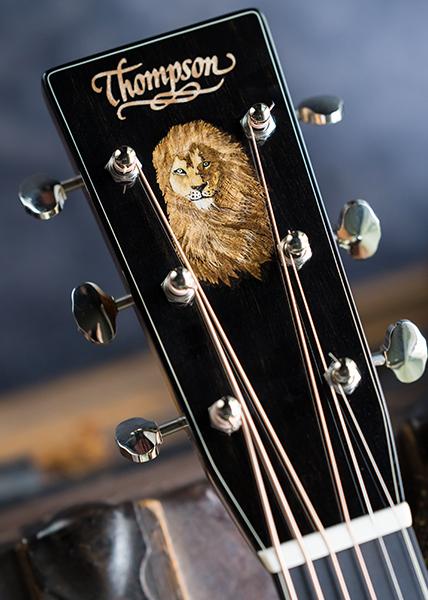
As a luthier, I’ve always been fascinated by the timeless elegance of wood and metal inlays. These materials offer a perfect balance of tradition and versatility. Wood inlays for guitars provide a warm, organic aesthetic that complements the instrument’s body beautifully. I often use exotic woods like ebony, rosewood, or maple to create stunning contrasts. On the other hand, metal inlays for guitars add a touch of brilliance and durability. Brass, silver, and even gold can be meticulously crafted into intricate designs that catch the light and the eye.
Through my experiences with the New England Luthiers group, I’ve learned that combining wood and metal inlays can yield truly spectacular results. The interplay between these materials allows for endless creative possibilities, from simple geometric patterns to elaborate pictorial scenes. What’s more, both wood and metal inlays can be customized to suit any style or genre, making them a versatile choice for guitar customization.
Choosing the Right Inlay Material
Aesthetic Considerations
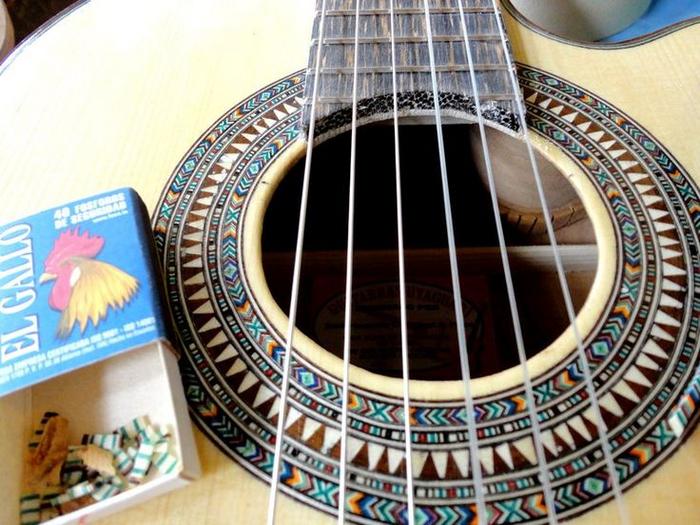
As a luthier, I’ve learned that aesthetic considerations are paramount when choosing inlay materials. My work in instrument design has taught me that the visual impact of an inlay can elevate a guitar from functional to extraordinary. When contemplating guitar aesthetic customization, I always consider how an inlay will complement the overall design, drawing from my experience in creating visually striking instruments. The right inlay can accentuate the wood grain, enhance the guitar’s shape, or tell a story through intricate patterns. I’ve found that balancing tradition with innovation often yields the most captivating results. Whether it’s a subtle mother-of-pearl fretboard marker or an elaborate abalone soundhole rosette, the aesthetic choice should resonate with the instrument’s character and the player’s personality. This harmonious blend of form and function is what transforms a guitar into a true work of art.
Durability and Maintenance
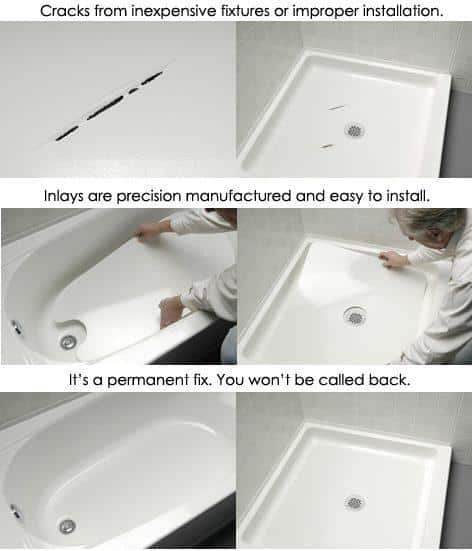
As an engineer-turned-luthier, I’m particularly concerned with the longevity of inlay materials. Through extensive research and hands-on experience, I’ve discovered that durability and maintenance play crucial roles in choosing the right decorative inlay materials. Different materials react uniquely to environmental factors and wear over time. For instance, mother of pearl maintains its luster but can be prone to cracking, while synthetic materials offer excellent durability but may lack the depth of natural materials.
I’ve observed that proper maintenance significantly extends the life of inlays. Regular cleaning and occasional polishing can preserve the beauty of most materials. However, some inlays, like certain woods, may require special care to prevent discoloration or warping. Understanding these nuances is essential for both luthiers and guitarists to ensure their instrument’s aesthetics remain stunning for years to come.
Guitar Inlay Techniques
Traditional Inlay Methods
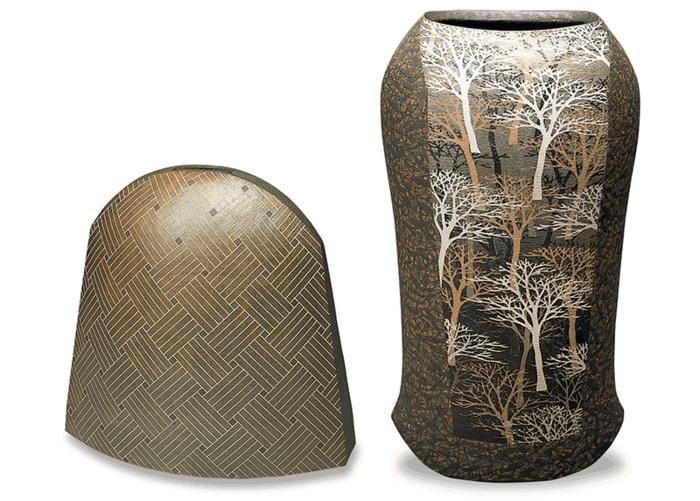
As a luthier with decades of experience, I’ve honed my skills in traditional inlay methods, a cornerstone of guitar craftsmanship. These techniques, passed down through generations, involve meticulously cutting and fitting luthier inlay materials into precisely routed cavities. I’ve found that mother-of-pearl and abalone remain the most revered choices for their luminescent beauty. The process begins with carefully selecting and shaping the inlay material, often using specialized tools like jeweler’s saws and files. Patience and precision are paramount as we delve into the delicate art of inlaying. Through my work, I’ve come to appreciate how these time-honored methods not only enhance a guitar’s aesthetics but also contribute to its overall character and value.
While modern techniques have their place, there’s an irreplaceable charm in the handcrafted nature of traditional inlays. This approach allows for a level of customization and artistry that truly sets a guitar apart. As we explore further inlay techniques, it’s essential to recognize the foundation laid by these traditional methods.
Modern Inlay Techniques

As we transition from traditional methods to modern inlay techniques, I’ve found my engineering background invaluable. Cutting-edge technologies have revolutionized the inlay process, allowing for unprecedented precision and creativity. One exciting development is the use of inlay powder for guitar, which offers a versatile and cost-effective alternative to solid materials. Through extensive experimentation, I’ve discovered that this powder can be mixed with epoxy resins to create stunning, customizable inlays with intricate details.
Moreover, laser cutting and CNC machining have transformed how we approach complex designs. These technologies enable us to achieve microscopic accuracy and replicate patterns that were once impossible by hand. I’ve personally pushed the boundaries by combining these modern techniques with traditional craftsmanship, resulting in unique hybrid inlays that blend the best of both worlds. As we continue to innovate, the possibilities for guitar inlays are expanding, offering luthiers and musicians alike new ways to express their creativity and enhance their instruments’ aesthetics.
DIY Guitar Inlay Projects
Planning Your Inlay Design
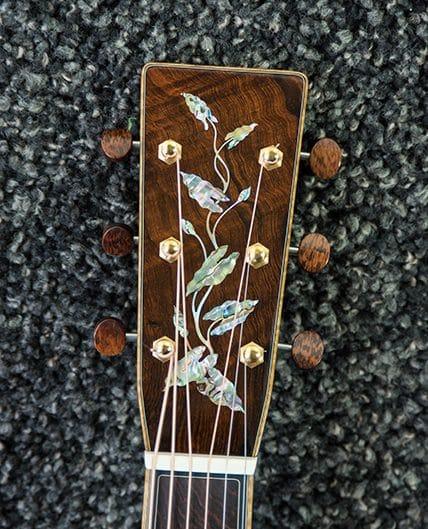
When it comes to planning your inlay design, I’ve learned that balance is key. My experience in instrument design has taught me the importance of careful planning. I’ll share some of the design principles I use to create harmonious and visually appealing inlays. First, I always consider the guitar’s overall aesthetic, ensuring the inlay complements rather than overwhelms. I start by sketching multiple ideas, playing with different shapes and patterns. It’s crucial to think about how the inlay will interact with the guitar’s existing features, like the fretboard markers or body shape. I also consider the technical aspects, such as the material’s properties and how it will be cut and installed. By thoroughly planning your design, you’ll avoid costly mistakes and create an inlay that truly enhances your instrument’s beauty.
Step-by-Step Inlay Process
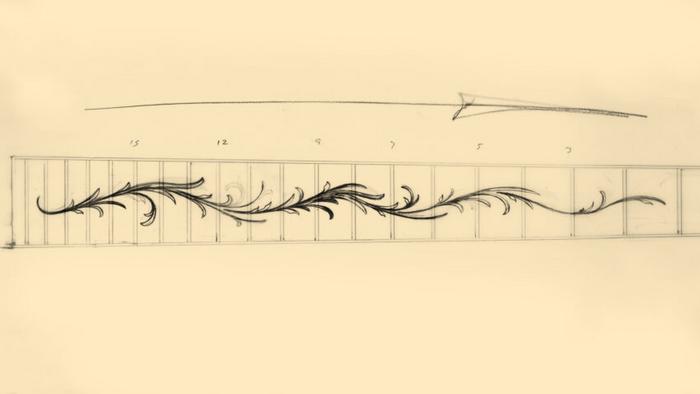
As we delve into the practical aspects of DIY guitar inlay projects, I’ll share my step-by-step process for creating stunning guitar fretboard inlays. Through years of experience and countless projects, I’ve refined this technique to achieve professional results. First, I carefully trace the inlay design onto the fretboard, ensuring precise placement. Then, I use a small router to create a shallow recess, meticulously matching the depth to the inlay material’s thickness.
Next, I prepare the inlay piece, often mother-of-pearl or abalone, by cutting and shaping it to fit the routed area perfectly. Applying a thin layer of adhesive, I carefully set the inlay in place. After the glue dries, I level the inlay flush with the fretboard surface using progressively finer grits of sandpaper. Finally, I apply a protective finish to enhance the inlay’s luster and protect it from wear. This process, while time-consuming, yields breathtaking results that truly elevate a guitar’s aesthetic appeal.
Professional Inlay Services
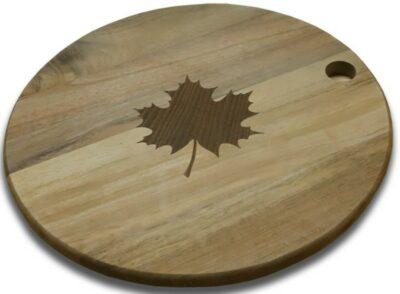
As a luthier with years of experience, I’ve had the privilege of collaborating with numerous inlay artists, each bringing their unique touch to the world of custom guitar inlays. Through my connections in the lutherie community, I’ve witnessed firsthand the artistry and precision that goes into creating stunning inlays. What separates a good inlay artist from a great one? The answer might change how you view your guitar forever. It’s not just about technical skill – it’s about vision, creativity, and an deep understanding of how inlays interact with the instrument’s overall aesthetics and playability.
When seeking professional inlay services, I always advise looking for artists who demonstrate a profound respect for the guitar’s integrity. The best inlay work enhances the instrument without overpowering it. I’ve seen masterpieces where intricate mother-of-pearl designs seem to dance along the fretboard, perfectly complementing the wood grain. Conversely, I’ve also encountered overzealous inlays that distract from the guitar’s natural beauty. A great inlay artist understands this delicate balance and works in harmony with the instrument’s character.
In my experience, the most exceptional inlay artists also possess an intimate knowledge of various materials and techniques. They can advise on which materials will best suit your vision and the guitar’s style, ensuring longevity and visual appeal. Remember, a truly professional service isn’t just about executing your design – it’s about guiding you through the process, offering insights, and sometimes gently steering you towards choices that will result in a truly magnificent instrument.
The History of Guitar Inlays
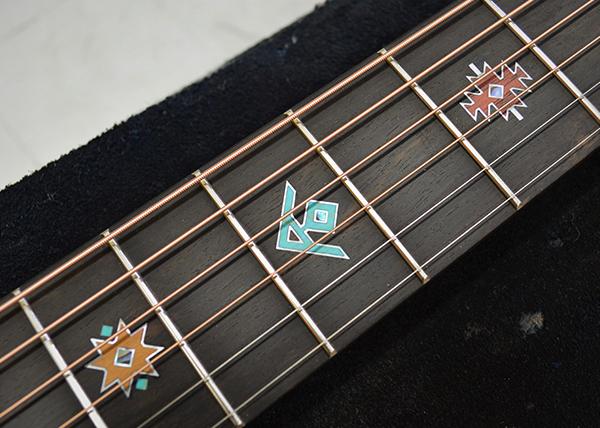
As I delved into the rich tapestry of guitar history, I’ve been fascinated by the evolution of inlays. Did you know that guitar inlays have roots tracing back to ancient civilizations?? Let’s embark on a journey through time. My research into the history of stringed instruments has given me a deep appreciation for the intricate artistry that adorns our beloved guitars.
The practice of inlaying decorative materials can be traced back to ancient Egypt and Mesopotamia, where craftsmen adorned furniture and musical instruments with precious stones and metals. As stringed instruments evolved, so did the art of inlay. In medieval Europe, I discovered that luthiers began incorporating bone and ivory inlays into lutes and early guitars, not just for aesthetics but also as fret markers.
The 19th century saw a surge in guitar decoration materials, with mother-of-pearl becoming increasingly popular. I was particularly intrigued by the ornate designs of Spanish and Italian guitars from this era. The industrial revolution brought new techniques and materials, leading to more intricate inlays. In my studies, I’ve noted how the Art Deco movement of the 1920s and 30s significantly influenced guitar inlay designs, introducing bold geometric patterns that still inspire modern luthiers today.
Regional Variations in Inlay Styles

In my years as editor of the Savart Journal, I’ve had the privilege of witnessing firsthand how guitar inlays serve as a global canvas for artistic expression. From the intricate patterns of the Middle East to the bold designs of the Americas, guitar inlays tell a story of global artistic diversity. This rich tapestry of styles has captivated me, revealing how deeply cultural heritage influences instrument aesthetics.
I’ve observed that European inlays often lean towards classical motifs, with floral patterns and heraldic symbols gracing the fretboards of many fine instruments. In contrast, North American designs frequently showcase nature-inspired themes, with soaring eagles and majestic landscapes being particular favorites. The intricate guitar purfling techniques I’ve seen in Spanish flamenco guitars are a testament to the region’s dedication to both visual and auditory artistry.
During my travels in Asia, I’ve been mesmerized by the delicate mother-of-pearl inlays depicting dragons and phoenixes, symbolizing harmony and rebirth. African guitar makers, on the other hand, often incorporate bold geometric patterns that echo their rich textile traditions. It’s this global diversity that continually reminds me of the guitar’s power to transcend cultural boundaries while simultaneously celebrating them.
FAQs
What are common materials used for guitar inlays?
How do inlays affect the sound of a guitar?
What are the benefits of using mother-of-pearl for inlays?
Can inlays be customized on a guitar?
How are inlays installed on a guitar?
Conclusion
As we conclude our journey through the world of guitar inlays, what will be your next step in this fascinating realm of artistry and craftsmanship? From the classic elegance of mother of pearl to the modern allure of synthetic materials, we’ve explored a diverse array of guitar inlay materials. Each option offers unique aesthetic and practical benefits, allowing you to personalize your instrument in ways that reflect your style and musical journey.
As I reflect on my journey from engineer to luthier, I’m continually amazed by the artistry and science behind guitar inlays. I hope this guide inspires you to explore the beautiful world of inlay materials and techniques. Whether you’re considering a DIY project or seeking professional services, remember that the right inlay can transform your guitar into a true work of art. The choice is yours – what story will your guitar tell?